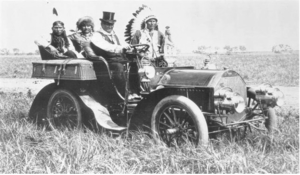
Intellectual legacies of colonization play a powerful role in shaping how mainstream U.S. and global society has come to see Native Americans. Artwork from the 19th and 20th centuries – such as James Earle Fraser’s sculpture, “The End of the Trail” – have helped to create the image of Native Americans on horseback as representations most associated with Indigenous populations of North America. Type “Native American” into a search engine, and you’ll likely get many historical images of Great Plains Indians. In parts of Europe as well, the perception of Native Americans has been shaped in unique ways by authors like Karl May and the later movies based on his books. Without a doubt, our students’ perceptions about Native Americans are influenced by these fantasies and representations.
In order to examine how sports mascots, seals and mottos as well as the noble and evil savage stereotypes shape the way Native Americans are perceived, I like to explore images like the one mentioned by Fraser, the character of Winnetou, but also Chancellor Scholz’s recent appearance on Bild Live, in which one ‘journalist’ appeared in a silly-looking Great Plains headdress. One of my favorite images combatting stereotypes is this one of Geronimo:

When shown this picture, students inadvertently assume that the person driving the car is white, and that the others are Native American. Yet, it is worthwhile to explore the story behind the picture. Actually, the entire group was Apache who had just attended church in their Sunday finest. The photographer had insisted that his Native American subjects dress up. The famous Geronimo, who the photographer had really wanted to capture, refused. He insisted, however, that the photo should feature his new car. So the most famous of all Apaches, Geronimo, is the only one in the picture who doesn’t look stereotypically Native. This image helps students to both explore the powerful stereotypes and the change that played an important role in Indigenous societies.
By claiming that Native people suffer from ‘invisibility’ in the United States, the website Reclaiming Native Truths: A Project to Dispel America’s Myths and Misconceptions points out that the invisibility is reinforced by the “limited personal experience and pervasive negative narrative set by others that cement stereotypes” about Native Americans. These perceptions emerge in part from the fact that “Americans value the ‘melting pot’” and, as a result, “blend tribes into a homogeneous culture.” Thus, it is essential for us as educators to not only underscore the tremendous diversity among Indigenous populations but also to bring in contemporary images and content into our teaching.
Focusing on the North American past before sustained European colonization can be one helpful strategy in unlearning stereotypes. Native American history before 1492 provides a glimpse at the trajectories of development and change that characterized Indigenous societies. Contrary to popular views about a scarcely populated North American ‘wilderness’, this was a world of tremendous complexity and diversity with urban areas the size of those in Europe, a prevalence of agrarian societies, intricate land management, and complex transcontinental exchange networks. Focusing on this early history also underscores that the lifeways based on horses and firearms in the American west was an Indigenous-driven adaptation spurred by European colonization in the early modern period.
In order to tackle misperceptions about Indigenous populations post 1492, we need to contextualize genocide, dispossession, disease, the history of slavery, racism, and social challenges. At the same time, it is crucial to underscore issues such as adaptation, resilience, survival, persistence, and the Indigenous struggle to maintain sovereignty. The histories of boarding schools, family separation, and allotment also provide powerful glimpses into the challenges faced by Native North Americans. Moreover, issues such as federal and state recognition and land claims, treaty rights, environmental issues, economic and cultural revitalization, and Native American activism are an important part of the story.
Finally, I’d like to present some resources that can help our students unlearn stereotypes. An especially concise, readable, and affordable one-volume-history on this subject is Roxanne Dunbar Ortiz’s An Indigenous Peoples’ History of the United States. For a volume that provides useful strategies on how to integrate Native Americans into your U.S. culture and history courses, see Susan Sleeper-Smith’s Why You Can’t Teach United States History Without American Indians. For some interesting, diverse, and short biographies, see Adrienne Keene’s Notable Native People. Drew Hayden Taylor’s book, Funny, You Don’t Look Like One, is always an eye-opening read to my students. His clarity and humor help them to reflect on the complex issues of Indigenous identity, stereotypes, and life in Canada.
Next, for a change of pace, music clips can spark interest in contemporary Indigenous culture. Emma Stevens’ viral Mi’kmaq version of the Beatles’ Blackbird is an impressive teaching tool.
https://youtu.be/99-LoEkAA3w
Although Montana hip-hop artist Supaman has recently embraced anti-COVID vaccination messages, his “Prayer Loop” mesmerizes students. Looking for something more with a Rock or Pop twist, music by Robby Romero and Red Thunder can serve you well. Moreover, clips by Sisters or DJ Shub provide a glimpse into the cultural vitality of North America’s Indigenous music scene.
Finally, the American Indian Digital History Project, the Smithsonian National Museum of the American Indian, and the “Invasion of America” are among my favorite websites.
The resources available are endless. Let’s use them to help students unlearn pervasive stereotypes.
4,748 Total Views, 3 Views Today






